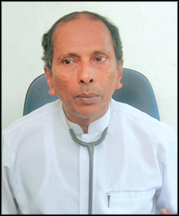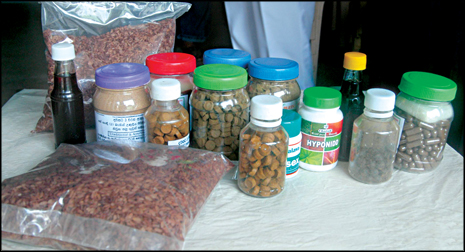Integrated method to treat diabetes
by Samangie WETTIMUNY
 |
|
Dr.Rathnapala presents a book which
contains his methods of treating diabetes to President
Mahinda Rajapaksa. |
Several campaigns and awareness programs were held during the past
few weeks to celebrate the World Diabetes Day which fell on November
14.More than 120 million people worldwide suffer from Diabetes and an
estimated 220 million people will be affected by this silent killer by
2020.
Though allopathic medicine has been the favourite method of treating
diabetes, attention is now being drawn to integrated medical systems
where a combination of Ayurvedic and Allopathic medicine is used to
treat this deadly disease. In countries like China there are even
universities such as the College of Integrated Medicine where they
practise this system.
Anyway, it seems that people are still not quite sure of this
treatment and the majority of them still tend to seek the assistance of
Western medicine practitioners. But as Traditional Ayurvedic Consultant
Physician, Dr. B.A. Rathnapala of Ropa Ayurvedic Hospital, Kottawa,
Mattegoda says more and more diabetic patients seek his assistance to
get rid of this deadly disease. Over forty percent out of 6196 patients
he treated from January 2005 to January 2008 have got completely cured
while others take treatment with much improved conditions.
People may think more lightly of diabetes than of cancer, but it is a
known fact that diabetes reduces life expectancy. As the name itself
suggests Ayurveda is the science of life and longevity. It not only
cures dreadful diseases but acts as a preventive measure as well. As Dr.
Rathnapala indicated the three main agents called doshas (Vaata Dosha,
Pitha Dosha and Kapha Dosha) are the determinants of the health of the
human body. If we are to be healthy those three should be in a balanced
state. Also 'Dhatus' should be in balanced state. If not, we are likely
to contract diseases very easily.
"According to Ayurveda, diabetes is classified as Kapaja Prameha,
Pittaja Prameha and Vataja Prameha. Altogether there are 20 types of
diabetes -10 types of Kapaja Prameha, 6 types of Pittaja Prameha and 4
types of Vataja Prameha, Kapaja Prameha is completely curable.
Patients who suffer from Pittaja Prameha have to be under medical
treatment during their entire life time. Vataja Prameha cannot be cured.
"But if the lifespan of a Vataja Prameha patient who takes western
medicine is 5 years, I can assure you that integrated medicine could
make their lifespan double.
"What people initially get is diabetes. If it is not treated properly
it may develop into diabetic mellitus in the long run. That is really
what I am worried about. It is mainly the wrong medical practices and
diet patterns that help diabetes to develop into diabetes mellitus."
 |
|
Dr. B.A. Rathnapala |
Showing several medical reports of his patients, he explained how
prolonged injection of insulin cause several other complications. "Major
issue is hyperlipidaemia (Cholesterol level increase) and Hypertension
(pressure)."
"Patients develop such types of complications because insulin is a
hormone which produces protein as well. It increases albumin.
It also produces fat (i.e. it improves cholesterol). Another
complication is when someone is under insulin, sodium reabsorption of
the kidney gets high. As Ayurveda states, 50% of diabetes can be cured.
Dr. Rathnapala says that there are three theoretical ways of describing
and proving this. "Bala Chikithsa, Ayurvedic scientific view and
according to modern physiology .
Bala Chikithsa
"Bala Chikithsa is a treatment used to improve the blood count - a
way of improving the bio-energy count of the human body. In fact, it is
an ancient treatment practised during my father's time. My father too
was a renowned Ayurvedic practitioner and in fact here I use the recipe
taken from his Ola leaves." As Dr. Rathnapala says it is essential to
give insulin to patients if their sugar level has reached Higher Upper
Level (more than 300) "in order to prevent them from getting into a
coma." "In such situations insulin is essential to save one's life. But
if you continue to rely on insulin for a longer period of time it can
even 'end' your life!
Citing examples from his patients he showed how he stopped giving
insulin to patients who have sought his medical advice.
"They had been under insulin for a long period. When you continue to
inject insulin the pancreas gets depressed and would reduce even the low
amount of insulin it produces at the moment. What you should keep in
mind is that not almost all diabetic patients need insulin. Only 5% of
patients need insulin supplement throughout their lives. But
unfortunately, it seems that some of the medical practitioners start
injecting insulin to patients without having proper understanding of the
type of diabetes the patient is having.
For example, if juvenile diabetics are given insulin from a very
early age and in the long run they are likely to develop lots of
complications." (This will be further discussed in the course of the
article.)
When asked about the unique feature of his treatment, Dr. Rathnapala
said that his medicine has the power to stimulate the pancreas, and
produce more insulin. So our medicine improves the serum insulin level
as well. Through diet and medicine the blood sugar level of patients can
be reduced. If not there is no other means to stop injecting insulin.
Also ayurvedic medicine contain more anti-oxidants and as such cells
always get sufficient amounts of oxygen. Our medicine also rejuvenates'
blood."
As mentioned earlier, it is not merely Bala Chikithsa and ayurvedic
methods that Dr. Rathnapala make use of. He uses western medicine as
well. In fact, it is an integrated method of treating diabetes. "For
some patients I give only half a tablet( 2.5 mg) of Glibencamide after
stopping injecting insulin. It is the only medicine which could
stimulate pancreas. But I do not use it for prolonged periods." "We
should make use of all types of medicine to ensure optimum efficacy.
Even in China they practise an integrated medical system. Here in Sri
Lanka we have even better herbs. In fact, what I want is to introduce my
way of treatment to others both in local and international arena. The
pill I want to introduce to local and international pharmacies is one
made out of 2.5mg of glibencamide combined with three types of herbal
medicine."
 |
|
Ayurvedic
medicine-Products of Ropa Ayurveda. Pix Chinthaka
Kumarasingha |
Dr. Rathnapala has even met President Mahinda Rajapaksa along with
his suggestions. "In fact it was Prof. Carlo Fonseka who took me to the
President as he was highly impressed by my method of treatment.The
President was pleased with my suggestions and he has referred them to
the Health Ministry." "There are several patients whom I have cured
completely. " he continued. In fact, some of them are even ready to be
contacted to share their "miraculous success story'" with others. Among
them are 4 doctors Speaker, five ministers, six Members of Parliament,
four provincial Council Members, two judges and three senior Police
officers."
One of the ways he practises is curing diabetes by enhancing
immunity.
There are so many complications of diabetes such as Ischaemic heart
disease, renal complication, retinopathy and neuropathy." Ayurveda is
specially worried about the heart diseases caused by diabetes.
Ischaemic heart disease arises as a result of insufficient blood
supply to the heart. Kidney damage too cannot be overlooked. Diabetes
retinopathy is one of the ways that affects your eyes. Initially the
focusing power of the eye changes due to swelling of the lens because of
the accumulation of sugar and water. Secondly, it may lead to two main
eye diseases - cataract and glaucoma. There are four types of diabetic
neuropathy- peripheral neuropathy (which most commonly affects feet and
legs.), autonomic neuropathy (which most often affects digestive system,
blood vessels, urinary system and sex organs), proximal neuropathy and
focal neuropathy.
Dr. Rathnapala emphasized the need to get the required tests done. If
you have any of the following complications, it is highly advisable to
get a test done and check whether you have diabetes.
Excessive thirst and dry mouth, passing large volumes of urine
several times a day, rapid weight loss, delayed wound healing,
impairment of eye sight, excessive tiredness and if you have a family
history of diabetes.
You should be always very careful of what you eat. Your diet should
include only the required amount of carbohydrate. The three main causes
we should treat are digestive power, serum insulin level and intake of
carbohydrate level.
For a diabetes patient medicine, diet and exercise matter alike .
"It is not quite necessary to have rice for dinner. We need rice only
in the morning and afternoon. The best thing is to have 'steamed
vegetables' for dinner. The best selection would be radish, Ladies
fingers, cabbage and fresh pumpkin.
As the doctor emphasized the type of food a patient could eat differs
from patient to patient. It depends on one's age, sex, weight and amount
of work done per day. "In the case of patients using insulin , it is
important that meals are taken at the recommended time.
"Diabetes patients should completely avoid any food item containing
sugar, syrups, jaggery, honey, soft drinks (jam, toffees, cake, sweets,
juices that contain added sugar, ice cream), condensed milk, yoghurt,
curd , and alcoholic drinking, ripe fruits except avocado and papaw."
You can moderately take 'par boiled rice', red rice, gram, green gram,
soya, cowpea and all items made from rice flour including string
hoppers, one egg once a week. 'Mallum,' bitter gourd, ladies fingers,
tender green beans, string beans, cabbage, fish, dry fish,sprats, bitter
tasting food, food rich with fibre, plantains, papaws and vegetable oils
could be added to your meals.
It is highly recommended to take bitter gourd, drumstick leaves, like
gotukola, sarana, kankun buds, kohila buds, vel kohila, onion leaves.
Beli leaves and flowers, Ranawara leaves and flowers and
Kothalahimbutu are suitable as drinks. It is advisable to take Nelli,
semi ripe plantains, madham fruits and Amberella.
"My sincere wish is may all beings be healthy. Finally I would like
to extend my gratitude to my late parents, my guru Ambewela Sarananda
Thera, K. G. P. Jayatileke, former Director of Institute of Indigenous
Medicine; S. D. Dayaratna, Jayantha Kumaranayake and G. W. Ariyadasa
(former lecturers of Institute of Indigenous Medicine who helped me
achieve this status)." He noted. |

